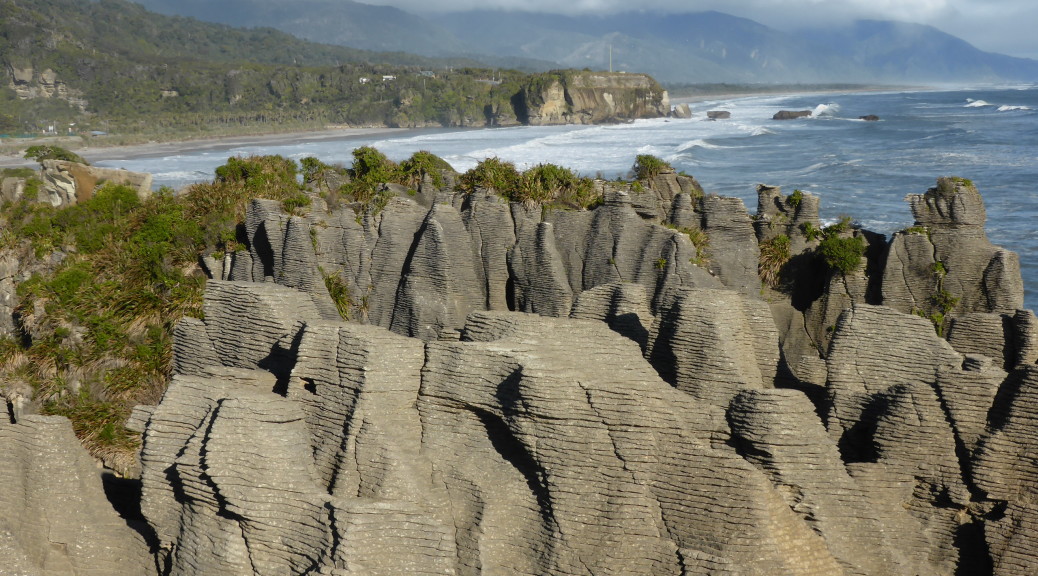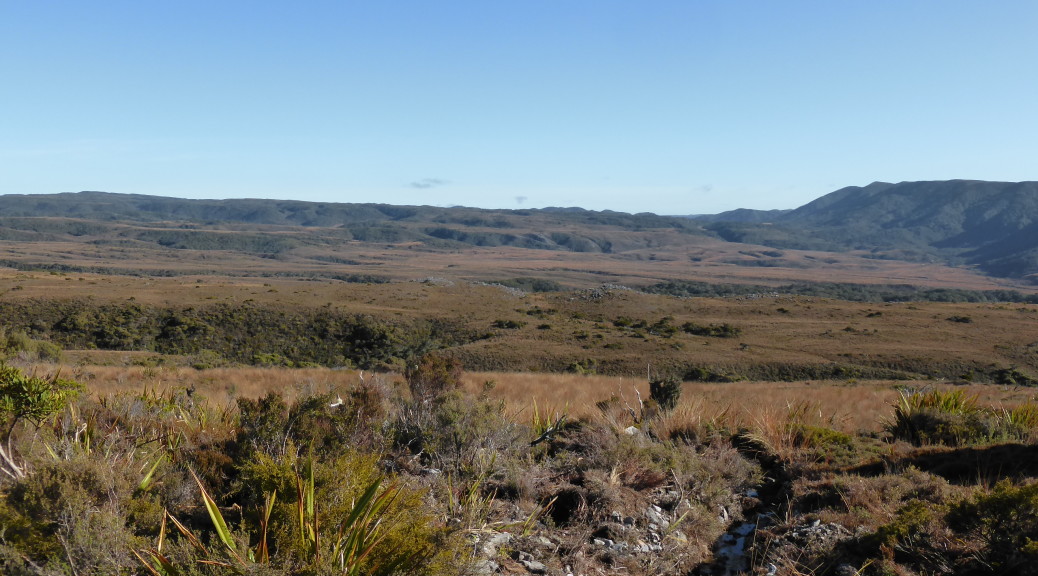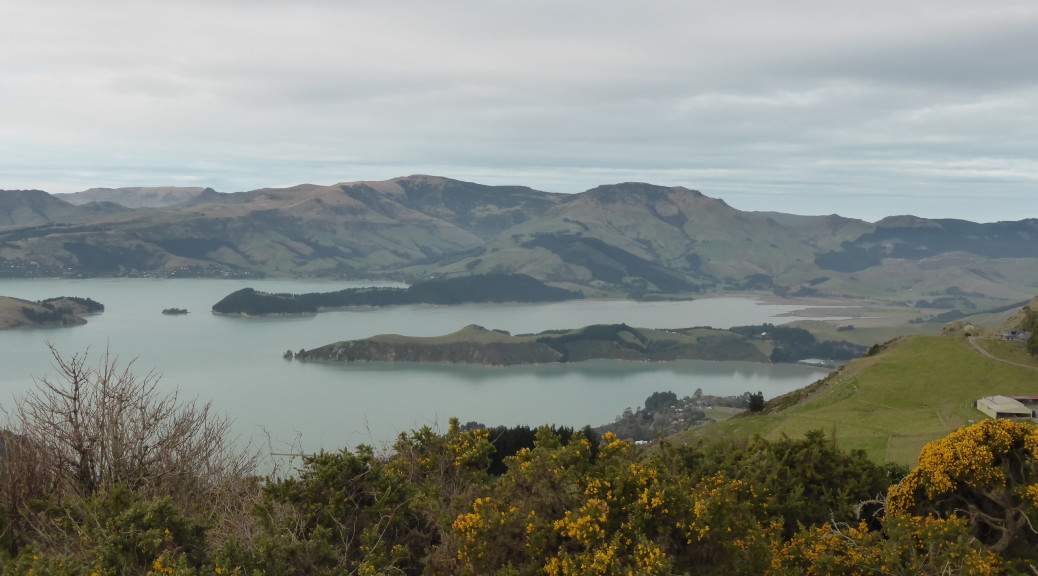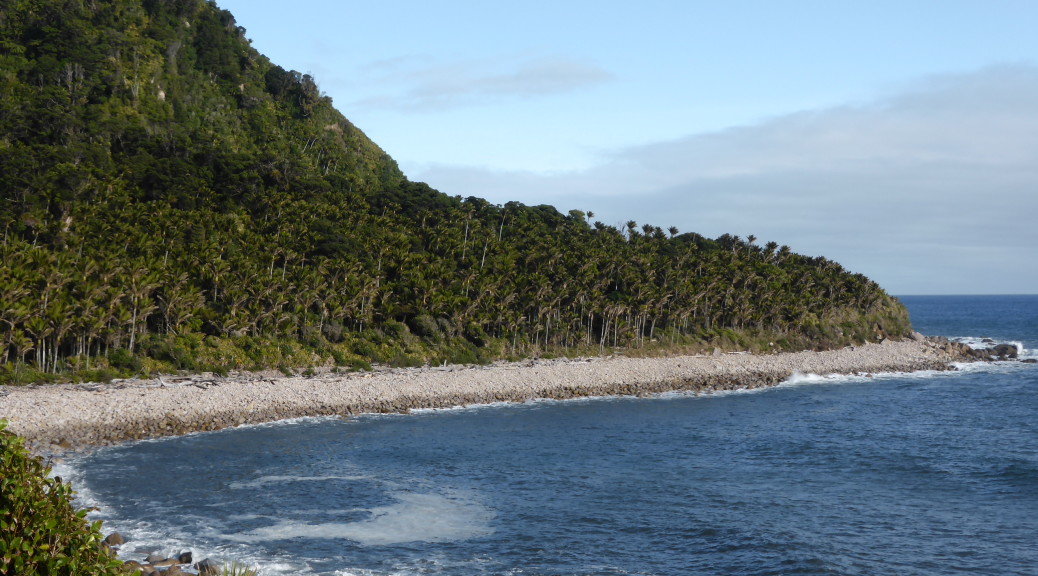Now that June is over, my weeks based in Westport are also coming to an end – it’s been a nice change of scenery. While somewhat wet, it has definitely been a lot less cold than if I’d spent the month further south at Mum & Dad’s house. Adele’s also been pleased to have various visitors, besides me, as we all realise just how isolated Westport is. With people new to the area, there is always added incentive to go out and show them new places.
Craig, Kelly and their young daughter, Elsie, visiting for a weekend meant a trip out to Charming Creek – I finally got to ride the whole thing (it’s only ten kilometres each way) after being stopped by a large trail-covering waterfall last time. We didn’t even get rained on! But there was plenty of water standing on the trail to soak us. The river not being in a raging, flooded torrent was not quite as impressive – but it did mean I got to see the most-noteworthy waterfall as we followed the fallen-into-disrepair railway up the valley.

 As with a lot of the coast, there were mining relics to explore. These at the top trailhead – where we turned around for a quick, fun and wet return to the cars.
As with a lot of the coast, there were mining relics to explore. These at the top trailhead – where we turned around for a quick, fun and wet return to the cars.
The girls having been for a Sunday mountain-bike ride up at Denniston while we (mostly Craig, admittedly) watched over Elsie – the late afternoon was time for Craig to take James and me on an adventure quite different to those I normally write about (no bikes!). Half an hour south, a bit past Charleston, we turned off the highway and followed a narrow gravel track inland and up into the hills. Craig declared we had found the right place as we parked the car – what he’d seen I had no idea, one patch of native bush looks much like any other. With a bit of advice I managed to get into my harness – as climbing things generally bores me, it’s been many years since I’ve had to put one on.
Someone saw a slight parting in the foliage and we set off down a narrow path, hiding the car keys in a small hovel trailside as the steps got steeper and more slippery. Surprisingly, there was an official sign warning of a tomo – which as far as I could work out was a really big hole in the ground. The surprise being the sign in such an isolated place; the large cavity in the earth being rather the point and not at all suprising. I stood around in the increasingly heavy rain getting rather wet, wondering why I wasn’t somewhere warm reading a book by a fire, as Craig and James set-up various ropes and slings that would, all going well, prevent me falling forty-odd metres and making little impression, but a big mess, on the rocks below.
With little time to do more than accept the fact that I’d be lowering myself a long way down a cliff with only a slight theoretical, and no practical, understanding of the hows and whys – I found myself doing just that. With a wet, doubled-rope threading through my belay device, it turns out being rather small and featherweight [disturbingly – if I was a boxer, I would be a featherweight; also, I’d probably be the worst boxer ever] does slow things down if you’ve not got the technique sorted. Still, in such circumstances I much prefer slow and steady over fast, uncontrolled and dead. The waterfall beside me cascading into the giant hole with much greater certainty and confidence was doing a fine job of making everything very slippery and more difficult. Eventually my technique improved and I descended a bit faster; one strand of rope ran out (a sixty metre rope can’t be doubled all the way down a forty metre cliff) and I bounced a little as I passed that by.
Somewhat relieved to be standing on solid ground, rather than bouncing off the side of it, James made his down and soon we were caving! Some photos of all this would be useful, but it was so muddy and wet down there I left my camera safely at home. For a couple of hours we proceeded through quite a network of tunnels downhill. We followed the stream part of the way, marveling at the large stalagmites and stalactites (some were a good eight inches in diameter) and appreciating the rather dainty ones forming that were no thicker than drinking straws.
It was a lot warmer underground than we expected – the others shed a layer or two, while I gave up trying to keep my feet dry and just walked in the stream when it became too much like hard work to stay out of it. Hauling ourselves up small rockfaces, clambering over things and gingerly jumping off rocks into semi-darkness was, as Craig said a few times, a full-body workout. I felt my shoulders twinge a couple of times from exerting force at weird angles – a warning that I shouldn’t pursue caving more, I’d hate to be stuck underground with a dislocated shoulder.
Craig reckoned he’d been down here four or five times before and seemed to know where he was going as I blindly followed, every so often hearing words along the lines of “this is the right way”. Every so often we’d emerge from a narrow passage into a larger chamber. It was one such chamber that we started to return to repeatedly after Craig started to utter the words “this doesn’t feel right” a little too often. This started to become mildly alarming after what seemed like half an hour. I was not keen on having to get myself back up that slick tomo in the dark. Eventually we had success as one previously overlooked passage sent us on the right track; we crawled and hauled ourselves on our bellies down another shrinking tunnel.
With Craig convinced we were back on the route that would get us back above ground, we elected to take a small side-route. This first involved a ten-metre shuffle head-first under an extremely low ceiling. I’ve not found too many instance where lacking in upper-body strength is useful, and this wasn’t one – but it was a good time to be very skinny. The ceiling was so low that I had to turn my boots parallel to the floor – as if I had my Size 8’s perpendicular, they would quickly wedge between ceiling and floor. Emerging from that, we were in a deep, but narrow cleft, in the rock. Soon this narrow chasm had a stream running swiftly down it, showing just what had carved such a deep slit in the layer rock. The layers were pronounced, but smooth as we shuffled past. Hardly having wide hips, even I had to twist my body sideways to be able to walk forward.
That rather unusual journey over we reached the objective – sizeable whale bones fossilised in the rock many metres below ground, but now somewhat exposed by the rock having been worn away. Amazed, we studied these for some time before deciding we really should get going and returned through the narrow passageway to the main route. With more shuffling down a muddy creek bed, we were finally able to stand up again and clambered up a lot of rock. Suddenly, Craig spotted ferns in the dark ahead – we were outside again and it was much later than we thought. With no real path, we headed up the left bank of the Nile (not that one) before Craig spotted some small reflectors off to our right. Following these had us bush-bashing through dense bush back to the gravel road, ending our fantastic little adventure with a half-hour walk up the road in the rain to the car and retrieving the rope from the start.
Later the following week, after a flying trip Napier (where I tested out Sounds Air’s new nine-seater service, Westport to Wellington), Fiona, a family friend of ours from growing up in Te Puke, arrived for a few days at the end of her med. school holidays. Around Westport, we went for walks to Cape Foulwind to see the seals, explored small local bike trails and waited for fine spots between the frequent showers of rain. Further south, we visited the Pancake Rocks at Punakaiki. Finding that the gravel road we intended to follow inland was closed due to slips, we explored another short walk nearby.

The Truman Track starts on the side of the highway and follows an easy path through a wide variety of native trees, before the bush finally thins and you find yourself above a rather charming little bay. I enjoyed exploring the bay, and the next one too (avoiding being stranded by the incoming tide), looking at the various wear patterns in the mudstone – while James, the geologist he is, looked more closely at rocks on the beach and Fiona tried to escape sandfly attacks.







A most excellent stay visiting the coast – the highlight was definitely the Heaphy, both trips – there’s a lot to do and more left unexplored for next time. Thanks Adele & James!


 This was a different view from the hut compared to last time – a lot less distant cloud and more snow.
This was a different view from the hut compared to last time – a lot less distant cloud and more snow.



 The rivers were crystal clear, but on such a chilly morning not at all inviting.
The rivers were crystal clear, but on such a chilly morning not at all inviting. The wet trail glinting in the early-afternoon sun before the slippery descent onto Gouland Downs.
The wet trail glinting in the early-afternoon sun before the slippery descent onto Gouland Downs. Looking out over the downs.
Looking out over the downs. As James pointed out, sections of the bush looked a little like giant bonsai trees.
As James pointed out, sections of the bush looked a little like giant bonsai trees. A rather pretty little stream.
A rather pretty little stream. I finally bothered to get a photo of one of these signs – the likes of which I’ve never seen on a mountain-bike trail before.
I finally bothered to get a photo of one of these signs – the likes of which I’ve never seen on a mountain-bike trail before.
 Looking out over the Hokitika River valley.
Looking out over the Hokitika River valley. There was the odd trail feature built – but I thought it a bit slippery to wisely attempt this.
There was the odd trail feature built – but I thought it a bit slippery to wisely attempt this. Yes, the trail disappears through a skinny tunnel. I was pleased not vanish into the ether halfway through.
Yes, the trail disappears through a skinny tunnel. I was pleased not vanish into the ether halfway through. It was disturbing to be suddenly spat out next to a new subdivision – at least we could see the mountains across the Canterbury Plains.
It was disturbing to be suddenly spat out next to a new subdivision – at least we could see the mountains across the Canterbury Plains. A herd of Banded Galloways were happened upon.
A herd of Banded Galloways were happened upon. We paused before our descent to look at more things in the distance.
We paused before our descent to look at more things in the distance. The McKirdy men looking at things in the distance.
The McKirdy men looking at things in the distance. How Jack managed almost thirty kilometres, I’ve no idea. A bit slower on the flat, he was much faster uphill than us and surprisingly quick down singletrack.
How Jack managed almost thirty kilometres, I’ve no idea. A bit slower on the flat, he was much faster uphill than us and surprisingly quick down singletrack. The upper reaches of Lyttelton Harbour – on the other side of the hills to Christchurch.
The upper reaches of Lyttelton Harbour – on the other side of the hills to Christchurch. About to head into the Flying Nun trail – an enormous amount of time has gone in to this one. Lined, almost paved, with plenty of natural rock it flows so well and is just one big bundle of fun!
About to head into the Flying Nun trail – an enormous amount of time has gone in to this one. Lined, almost paved, with plenty of natural rock it flows so well and is just one big bundle of fun!


 With the tide far enough out, there was a short section on a beach – avoiding the high-tide alternative track.
With the tide far enough out, there was a short section on a beach – avoiding the high-tide alternative track. Plenty of stream and river crossings gave opportunities to emerge from the trees into the rain.
Plenty of stream and river crossings gave opportunities to emerge from the trees into the rain. Eventually, it stopped raining – about the time we reached the Heaphy River mouth and our lunch stop at Heaphy Hut.
Eventually, it stopped raining – about the time we reached the Heaphy River mouth and our lunch stop at Heaphy Hut.
 Adele crossing the Heaphy.
Adele crossing the Heaphy.
 It’s a pretty damp climate with plenty of interesting flora and fauna.
It’s a pretty damp climate with plenty of interesting flora and fauna. Looking all the way back down to where we’d been for lunch the previous day.
Looking all the way back down to where we’d been for lunch the previous day. Bike racks and wash area – at a hut, wow!
Bike racks and wash area – at a hut, wow! Adele enjoying the downhill – possibly this was before she fell off the side of a bridge, but it’s hard to tell as she’s always got a smile on her face.
Adele enjoying the downhill – possibly this was before she fell off the side of a bridge, but it’s hard to tell as she’s always got a smile on her face. While waiting for Adele, James and I tried talking to the friendly locals. This robin was particularly curious, and the many fantails we saw elsewhere were super inquisitive.
While waiting for Adele, James and I tried talking to the friendly locals. This robin was particularly curious, and the many fantails we saw elsewhere were super inquisitive. Occasionally there were glimpses of the Heaphy River – but annoyingly there were no great lookout spots on the way down.
Occasionally there were glimpses of the Heaphy River – but annoyingly there were no great lookout spots on the way down. Looking east up a tributary of the Heaphy – some good limestone cliffs to on the right.
Looking east up a tributary of the Heaphy – some good limestone cliffs to on the right. After a rapid pace on the flats back to Heaphy Hut we got strangely hot – a good time for lunch; the nikau palms began to reappear also.
After a rapid pace on the flats back to Heaphy Hut we got strangely hot – a good time for lunch; the nikau palms began to reappear also.



